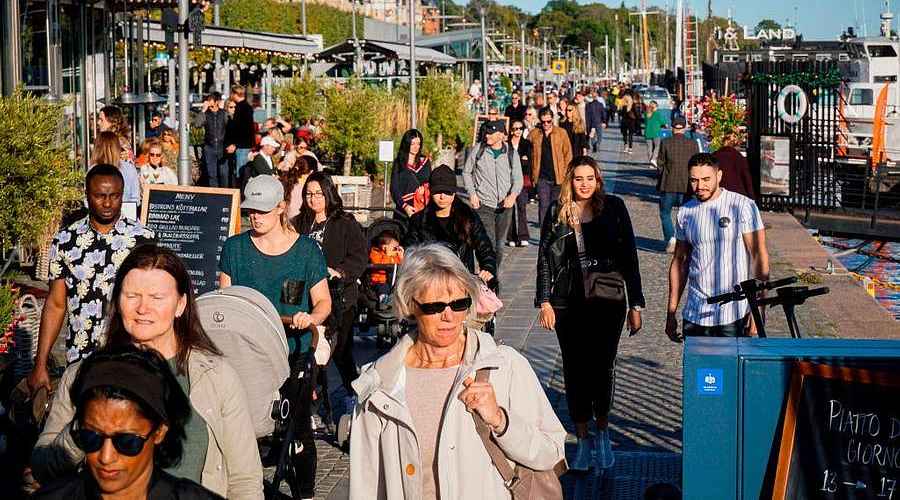






See listing of Recent and Most Popular articles on the Home Page
Health & Wellness
Category: News & Current Events / Topics: COVID-19 • Crisis • Dying and Death • Demographics • Disease • History • News • Statistics
Sweden's Pandemic Experiment
by Mallory Pickett / The New Yorker
Posted: April 10, 2021
When the coronavirus arrived, the country decided not to implement lockdowns or recommend masks. How has it fared?…
Editor's Note: When the COVID-19 pandemic struck in early 2020, Sweden defied the lockdown approach of most other countries. New Yorker writer Mallory Pickett, whose husband is Swedish, looked into "Sweden's Pandemic Experiment" in an April 6, 2021 article. Following are excerpts, roughly divided along the timeline of COVID-19 (we added the underlined section headings), with a link to the full article and some additional information in an "Editor's Postscript" at the bottom of the page.
Beginning: March 2020
On a gloomy afternoon in March, 2020, Angelica Jularbo, a nurse, was in her office at a high school in Stockholm, when one of her students came in complaining of a headache. Jularbo, a mother of four, projects the mixture of sternness and warmth that one expects from a nurse. In the previous month, COVID-19 had begun sweeping across Europe, but Swedish schools remained open. As Jularbo bent to take the student’s temperature, the student coughed and then said, “Oh, maybe I should tell you, my partner has been diagnosed with corona.” Jularbo ordered the student to go home immediately. “Don’t go back to class to get your bag,” she said. “We’ll have someone bring it to you.”
Four days later, Jularbo woke with a fever and a splitting headache. “I understand why people who are really sick, or people who are in excruciating pain, say, ‘I just want to die,’ ” she told me. She was so tired that she couldn’t leave her room for several days. One morning, she made tea and sat on the couch, determined to see her children off to school; she woke up to the sounds of them coming home, tea cool on the table. After nine days, the last two symptom-free, she went back to work. But a week later the headache and fever returned. She locked herself in her office to avoid exposing anyone. “I was so, so scared that I had made someone else in the office sick,” she told me.
Jularbo’s illness came at a pivotal time for Sweden. While lockdowns, curfews, and travel bans were being rolled out across the rest of the world, Swedish restaurants, stores, bars, museums, day cares, and elementary schools all remained open. People were encouraged to work from home and to reduce travel, but both were optional. Masks were not recommended and remained rare. Households could mix; until the end of March, even parties of up to five hundred people were allowed. The man behind Sweden’s coronavirus response is Anders Tegnell, the country’s head epidemiologist. Tegnell worked in Zaire during the 1995 Ebola epidemic, and then served as an expert on infectious diseases for the European Union before being hired by the Swedish public-health agency, in 2013.
The Swedish constitution gives government agencies extraordinary independence, so Tegnell and the public-health agency have led much of the coronavirus response, and, constitutionally, the government has little power to impose restrictions. Tegnell, who is sixty-four and tall, with round glasses, has often said that lockdowns are not supported by science and that the evidence for mask-wearing is “weak.” His stance is a startling departure from the scientific consensus, but he maintains that if other countries were led by experts rather than politicians, more nations would have policies like Sweden’s. The world has been left gawking. American liberals were shocked that the country of Greta Thunberg could seem so scientifically backward. Right-wing activists in Minnesota held up signs during anti-lockdown protests reading “Be Like Sweden.” Within the country, Tegnell has become an icon of Swedish exceptionalism, believed to be excessively reasonable, levelheaded, and rational. Supporters praised him for not giving in to political panic. Wearing a mask in Sweden was sometimes seen as a signifier of being anti-science.
Jularbo has many friends and colleagues who contracted COVID-19, and her case was severe. But I met her in the “Anders Tegnell Fan Club” on Facebook, which contains a smorgasbord of multimedia tributes:. . . “At the beginning, I didn’t like Anders Tegnell,” she said. “But the more I have heard about him, the more time has gone by, the more I love him.”
Sweden's "Light-Touch" approach
Tegnell introduced the country’s light-touch approach to the pandemic in March, as cases were mounting. Internal e-mails obtained by the freelance journalist Emanuel Karlsten show that the government at least considered whether the strategy might lead to more widespread immunity. In an e-mail exchange between Tegnell and the head of the Finnish public-health agency, on March 14th and 15th, Tegnell suggested that keeping the schools open could help the young and healthy develop immunity sooner. His Finnish colleagues noted that their models found that closing schools would decrease the infection rate among the elderly by ten per cent. Tegnell responded, “Ten percent might be worth it?”
However, Sweden seems to have settled on its final strategy primarily through a mix of unorthodox scientific conclusions, pragmatism, and folkvett, a particularly Swedish notion of common sense. No epidemiologists thought that self-isolation should be a long-term solution. “Lockdown is a temporary measure that you do to buy you time,” David Nabarro, a long-time United Nations adviser and one of the World Health Organization’s special envoys on COVID-19, told me. But most countries were unable to get the virus under control and decided to leave lockdowns in place until a vaccine became available. This seemed unsustainable to Tegnell. He also shirked masks. A year ago, there were few studies that directly measured the impact of masks on viral-particle emissions and community spread of the virus, and controlled experiments were difficult to conduct, for logistical and ethical reasons. Over the course of the pandemic, evidence supporting masks has piled up. . . . Yet Tegnell remained unsatisfied. In April, 2020, he wrote a letter to the European Center for Disease Control urging against a mask recommendation, saying, “The argument for and evidence for an effect of face covering to limit the spread from asymptomatic persons is not clear. . . . The arguments against are at least as convincing.”
As the Swedish strategy garnered attention, Johan Giesecke, Sweden’s former head epidemiologist, told UnHerd, a British YouTube channel, that he expected the infection fatality rate to be “much, much lower” than was being reported in the media at the time. “I think it will be like a severe influenza rate, on the order of 0.1%.” (A study by the Swedish public health-agency later found that the rate was at least six times higher in Stockholm.) He said that the difference between Sweden and other countries’ policies was that “the Swedish government decided early, in January, that the measures we should take against the pandemic should be evidence-based. And when you start looking around at the measures that are being taken now by other countries, you find that very few of them have a shred of evidence.” . . . On March 16th, scientists at Imperial College London published a paper, based on an epidemiological model, predicting that, unless some form of lockdown was imposed, more than five hundred thousand Brits would die from preventable COVID-19 infections. A week later, the Prime Minister, Boris Johnson, announced that his government would be closing schools, bars, and restaurants, falling in step with the rest of Europe. “It was slightly frustrating,” Tegnell told me, when I spoke to him, in August. “We were really hoping we could take us through this crisis together.”
Spring 2020: cases soar, modifcations made
Sweden is a country of ten million people, about the size of Los Angeles County, and almost twenty per cent of Swedes live in Stockholm, the largest city. In April, 2020, a widely-circulated pre-print version of a paper by researchers at Uppsala University, adapting the Imperial College model, predicted that, under the Swedish strategy, fifty per cent of susceptible Swedes would be infected within thirty days, resulting in over eighty thousand deaths by July. That spring, the virus began spreading unchecked in Sweden. “It just kept adding up,” Tegnell said. “I mean, you’re always kind of hopeful and think that, O.K., this is something that’s going to pass over.” Soon, the per-capita death toll was among the highest in Europe. Slight modifications were made to the Swedish advice: visitors to nursing homes were banned on March 30th; people were not allowed to gather in groups larger than fifty. Tegnell told me that the death toll weighed on him. “I think this was a big frustration and feeling of failure for us,” he said. But he remained steadfast, often saying, in interviews, “Judge me in a year.” . . .
Summer to the end of 2020
This summer, case counts began to drop in Sweden. When I spoke to Tegnell at the end of August, he felt that the worst was behind him. Just a few weeks later, he and other international experts had a special audience with Boris Johnson, to give advice on how Sweden had brought numbers down with their light-touch approach. “I think we are reasonably optimistic,” he said. “Our prognosis is, No, we don’t really see a huge second wave coming on.” This did not last. By December, cases and hospitalizations were higher than they’d been since the earliest days of the pandemic. Intensive-care units in Stockholm and Malmö, the country’s third biggest city, were full. “It was just this development we did not want to see,” Björn Eriksson, Stockholm’s director of health and medical care, said during a press conference. Confidence in the public-health agency had fallen from sixty-eight per cent in October, to fifty-two per cent in December. The government appointed an independent commission to investigate the Swedish response to the pandemic, and passed a new law temporarily allowing the state to close businesses as needed.
Tegnell’s prediction of a tapering epidemic curve and quickly-attained immunity never came to pass. Sweden’s per-capita case counts and death rates have been many times higher than any of its Nordic neighbors, all of which imposed lockdowns, travel bans, and limited gatherings early on. Over all in Sweden, thirteen thousand people have died from COVID-19. In Norway, which has a population that is half the size of Sweden’s, and where stricter lockdowns were enforced, about seven hundred people have died. It’s likely that some simple policy changes—especially shutting down visitations to nursing homes sooner, and providing more P.P.E. and testing to nursing-home staff—would have saved lives. And the strategy doesn’t seem to have helped the economy much: the Swedish G.D.P. fell by around three per cent, better than the European average, but similar to the drop in other Nordic countries. . . .
"Not the worst off"
But, although the outcome in Sweden was a black spot in Scandinavia, “compared to other countries in Europe, it’s not the worst off,” Patrick Heuveline, a professor of sociology at U.C.L.A. who studies pandemic mortality rates, told me. “It’s not as bad as Italy, Spain, the U.K., and Belgium for example.” Tegnell holds up this statistic when defending his strategy, claiming that sparsely-populated Norway and Finland are the outliers, and that Sweden should be compared to the rest of Europe. . . .
Even so, Sweden’s death toll was not as high as some predicted. It will not be easy to tease out the precise reasons for this outcome. In a recent piece for this magazine, Siddhartha Mukherjee noted that, while some countries were ravaged by the pandemic, others had far lower death rates than expected. The reasons for this, he noted, remain an “epidemiological mystery.”. . .
There may also be factors that we’re not yet aware of. “We’ve just got to be humble about what we know and what we don’t know. And we still don’t know a lot,” Howard Forman, a professor of public-health and management at Yale, told me. Protections that seemed important may turn out, after long-term study, to have been less effective than we thought. “If you, one day, come to me and say that masks only reduce spread by fifteen per cent or even ten per cent, I’d be like, O.K., well, that’s within range. It’s not a total shock. And, by the way, I would still say it was worth wearing the masks.” . . . Almost exactly a year from the pandemic’s start, Tegnell said that he believes people should still hold off on judging his policies. “The pandemic is not over,” he said. “Any kind of final review on what’s been good and what’s been bad still awaits us.”
The jury is still out
Sweden remains divided on its government’s response to the pandemic. On December 18th, as hospitals were already braced for a post-Christmas surge, Tegnell and the public-health agency finally recommended wearing masks—but only on public transit and only during rush hour. (Tegnell sees distancing as the most important barrier to the virus—“Masking is not a golden bullet,” he said—and only recommends the use of masks where distance cannot be maintained.) Days after this new rule was passed, I asked Tegnell whether he still thought the evidence for masks was “sketchy.” “Yes,” he responded. “Unfortunately, there is not much new evidence in place.” But he told me that he had decided that it was better not to take chances. “Due to the developments we see, we need to use even measures where evidence and effect is low,” he said. Swedes are slowly making masks a part of their pandemic routines. My mother-in-law has bought some masks to wear on buses and trams. She and my father-in-law continue to see a small circle of friends, but they celebrated Christmas alone, seeing their grandchildren only on small screens.
Read the full article at The New Yorker.
Editor's Postscript
The latest statistics comparing Scandinavian countries, by population (from 215 counties analyzed by worldometers.info) indicated the following, as of April 10:
- Sweden: population 10.1-million (90th in world); 857-thousand cases (27th in world, 8.4% of population); 13,621 deaths (33rd in world, 1.6% mortality rate)
- Denmark: population 5.8-million (113th in world), 237-thousand cases (62nd in world, 4.0% of population), 2,439 deaths (74th in world, 1.0% mortality rate)
- Finland: population 5.5-million (115th in world), 82-thousand cases (97th in world, 1.5% of population), 868 deaths (100th in world, 1.1% mortality rate)
- Norway: population 5.4-million (117th in size), 102-thousand cases (88th in world, 1.8% of population), 684 deaths (105th in world, 0.7% mortality rate)
- Iceland: population 343-thousand (177th in size), 6,258 cases (158th in world, 1.8% of population), 29 deaths (176th in world, 0.5% mortality rate)
By comparison:
- Gobal: population 7.8-billion; 136-million cases 1.7% of population); 2.9-mlliion deaths (2.1% mortality rate)
- Europe: population 748-million (3rd among continents), 41.5-million cases (1st among continents, 30.5% of world cases, 5.5% of own population), 948,947 deaths (1st among continents, 2.3% mortality rate)
- United States: population 333-million (3rd in world), 31.8-million cases (1st in world, 23.4% of world cases, 9.5% of own population), 575,553 deaths (1st in world, 1.8% mortality rate)
For additional details and trends for the top countries for COVID-19 cases, deaths, testing and other factors, see Stu Johnson's latest report on SeniorLifestyle, "COVID-19 Numbers for March."
The Swedish approach is not unlike the reopening approaches currently under way in some U.S. states, and similar to "Focused Protection" approach endorsed by more than 55-thousand American health care scientists and practitioners who have signed the "Greater Barrington Declaration," as well as a personal account by Scott W. Atlas of the Hoover Institution at Stanford University, "Science, Politics, and COVID: Will Truth Prevail?"
Search all articles by Mallory Pickett
Posted: April 10, 2021 Accessed 965 times
![]() Go to the list of most recent Health & Wellness Articles
Go to the list of most recent Health & Wellness Articles
![]() Search Health & Wellness (You can expand the search to the entire site)
Search Health & Wellness (You can expand the search to the entire site)
![]() Go to the list of Most Recent and Most Popular Articles across the site (Home Page)
Go to the list of Most Recent and Most Popular Articles across the site (Home Page)
 Loading requested view...
Loading requested view...